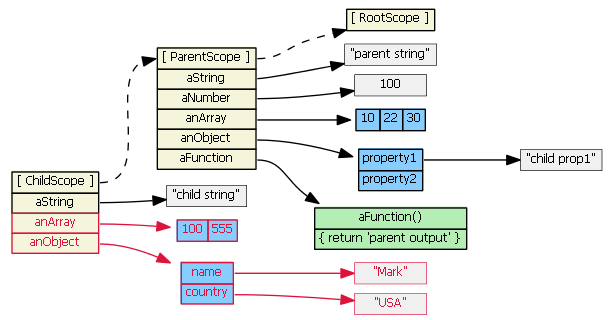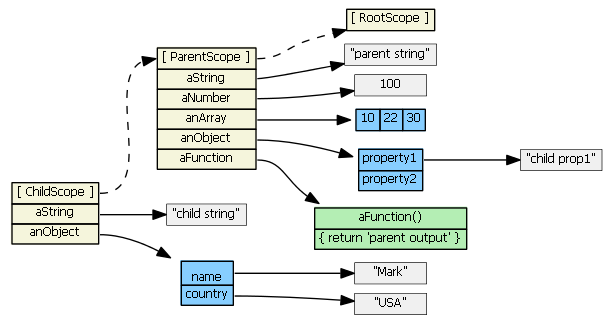剖析AngularJS作用域
| 一、概要 |
在AngularJS中,子作用域(child scope)基本上都要继承自父作用域(parent scope)。
但,事无绝对,也有特例,那就是指令中scope设置项为对象时,即scope:{…},这将会让指令创建一个并不继承自父作用域的子作用域,我们称之为隔离作用域(isolated scope)。
指令中的scope一共可以有三个值,下面我们再来温习下:
|
指令之scope |
|
|
scope: false |
默认值,指令不会新建一个作用域,使用父级作用域。 |
|
scope: true |
指令会创建一个新的子作用域,原型继承于父级作用域。 |
|
scope: {…} |
指令会新建一个隔离作用域,不会原型继承父作用域。 |
那么,理解AngularJS中作用域继承有什么用呢?
原因之一就是,有利于我们使用“双向绑定”(也就是在form表单元素中绑定ng-model),例如,在初学AngularJS时,我们常会遇到“双向绑定”不起作用的时候,如下:
<!DOCTYPE html>
<head>
<meta charset="utf-8"/>
<script src="angular.js"></script>
</head>
<body ng-app="myApp">
parent:<input type="text" ng-model="name"/>
<div ng-controller="TestCtrl">
child: <input type="text" ng-model="name"/>
</div>
<script>
var app = angular.module('myApp', []);
app.controller('TestCtrl', function(){});
</script>
</body>
</html>
执行上述代码,结果如下:

其实AngularJS的作用域继承与JavaScript的原型继承是一样的逻辑,固,如果想要上述代码实现双向绑定,我们可以利用ng-model绑定对象属性,来达到目的,如下:
<!DOCTYPE html>
<head>
<meta charset="utf-8"/>
<script src="angular.js"></script>
</head>
<body ng-app="myApp">
parent:<input type="text" ng-model="obj.name"/>
<div ng-controller="TestCtrl">
child: <input type="text" ng-model="obj.name"/>
</div>
<script>
var app = angular.module('myApp', []);
app.run(function($rootScope){
$rootScope.obj = {};
});
app.controller('TestCtrl', function(){});
</script>
</body>
</html>
执行上述代码,结果如下:

该篇博客原文地址:http://www.cnblogs.com/giggle/p/5769047.html
| 二、JavaScript原型继承 |
上面已经提到了AngularJS的作用域继承与JavaScript的原型继承是一样儿一样儿的,所以,我们首先来初步温习下JavaScript的原型继承。
假设,我们有父作用域(ParentScope),且其中包含了属性aString、aNumber、anArray、anObject 以及aFunction。
好了,如果现在有一子作用域(ChildScope)继承于这个父作用域(ParentScope),如下所示:

当我们通过ChildScope想访问一个属性时,JavaScript内部是如何为我们查找的呢?
答案:
首先JavaScript会第一时间在当前作用域(如这里的ChildScope)中查找是否有这一属性,如果在当前作用域中没有找到,
那么JavaScript就会沿着原型这条链(如这里的:ChildScope-->ParentScope-->RootScope),一直找下去,倘若在某一父作用域中找到,就返回这个属性值并停止原型链查找;
倘若一直找到根作用域(如这里的RootScope)都没有找到,则返undefined。
故而,下面这些表达式,结果都为true:
childScope.aString === 'parent string' //true childScope.anArray[1] === 20 //true childScope.anObject.property1 === 'parent prop1' //true childScope.aFunction() === 'parent output' //true
好了,假如,我们这么做呢:
childScope.aString = 'child string'
那么只会在childScope中新建一个值为’child string’的aString属性。在这之后,倘若我们还想通过childScope访问parentScope中aString属性时,就束手无策了。
因为childScope已经有了一个aString属性。理解这一点是非常重要的,在我们讨论ng-repeat 和ng-include之前。

接下来,我们再这么做呢:
childScope.anArray[1] = '22' childScope.anObject.property1 = 'child prop1'
这样会沿着原型链查找的,并改变属性中的值。
为什么呢?
原因就是我们这次赋值的是对象中的属性。

好了,接下来,我们再这么做:
childScope.anArray = [100, 555]
childScope.anObject = {name: 'Mark', country: 'USA'}
这样做的效果,如同上面childScope.aString = ‘child string’一样,不会启动原型链查找。

总结:
1、如果我们读取子作用域的属性时,且该子作用域有这个属性,则不会启动原型链查找;
2、如果我们赋值子作用域的属性时,依然不会启动原型链查找。
1、If we read childScope.propertyX, and childScope has propertyX, then the prototype chain is not consulted.
2、If we set childScope.propertyX, the prototype chain is not consulted.
EnglishExpression
通过上面的总结,如果我们想让childScope在已有自己的anArray属性后,仍然访问parentScope中的anArray值呢?
哈哈,删除childScope中的anArray属性嘛,如下:
delete childScope.anArray childScope.anArray[1] === 22 //true

| 三、Angular作用域继承 |
在前面“概要”部分已经说到Angular中子作用域基本上都继承自父作用域,但也有例外(scope:{…}指令),但并没有具体说明哪些指令会创建子作用域等,现在归类如下:
|
创建子作用域,且继承自父作用域 |
1、 ng-repeat 2、 ng-include 3、 ng-switch 4、 ng-controller 5、 directive (scope: true) 6、 directive(transclude: true) |
|
创建子作用域,但并不继承自父作用域 |
directive(scope: {…}) |
|
不创建作用域 |
directive(scoep: false) |
下面分别看看:
--ng-include--
假设我们有一控制器,内容如下:
module.controller('parentCtrl', function($scope){
$scope.myPrimitive = 50;
$scope.myObject = {aNumber: 11};
});
有HTML代码如下:
<div ng-controller="parentCtrl">
parent-myPrimitive:<input type="text" ng-model="myPrimitive"/><br/>
parent-obj.aNumber:<input type="text" ng-model="myObject.aNumber"/><br/>
<script type="text/ng-template" id="/tpl1.html">
includ-myPrimitive:<input ng-model = "myPrimitive"/>
</script>
<div ng-include src="'/tpl1.html'"></div>
<script type="text/ng-template" id="/tpl2.html">
includ-obj.aNumber:<input ng-model="myObject.aNumber"/>
</script>
<div ng-include src="'/tpl2.html'"></div>
</div>
代码稍长,请自行打开
因为每个ng-include指令,都会创建一个新的作用域,且继承于父作用域。固,代码中的关系图如下:

在chrome(需加--disable-web-security)下,执行上述代码后,得下:

从执行结果看,符合上面的关系图。
好了,倘若我们在第三个input框中,敲入字符(如77)后,子作用域会创建一个自己的myPrimitive属性,从而阻止原型链查找。
如下所示:


倘若,我们在第四个input框中,输入字符(如99)呢?子作用域会沿着原型链查找并修改,因为在这个input框中,我们绑定的是对象属性。
如下图所示:


如果我们想让第三个input框达到第四个input框的效果,并且不使用对象属性的方法,那么我们可以利用$parent来达到目的。
修改第三个input框的HTML代码:
includ-myPrimitive:<input ng-model="$parent.myPrimitive"/>
好了,这个时候,我们再在第三个input框中输入22时,就会沿着原型链查找了,达到与第四个input框一样的效果(因为$parent是为了让子作用域访问父作用域设置的属性)。

除开$parent,还有$$childHead和$$childTail都是为了子作用和父作用域通信服务的。注意,是所有子作用域哦,所以包括了scope:{…}指令的情况。
--ng-switch--
ng-switch会创建子作用域,效果与上面所述的ng-include一样。倘若,我们想要实现子作用域与父作用域实现双向绑定,就使用$parent或者对象属性。
Demo如下:
<!DOCTYPE html>
<head>
<meta charset="utf-8"/>
<script src="angular.js"></script>
</head>
<body ng-app="myModule">
<div ng-controller="parentCtrl">
<input type="text" ng-model="obj.something"/>
<div ng-switch="name">
<div ng-switch-when="Monkey">
<h1>This is Monkey</h1>
<input type="text" ng-model="obj.something"/>
</div>
<div ng-switch-default>
<h1>This is Default</h1>
</div>
</div>
</div>
<script>
var module = angular.module('myModule', []);
module.controller('parentCtrl', function($scope){
$scope.obj = {};
$scope.name = "Monkey";
});
</script>
</body>
</html>
代码稍长,请自行打开
执行上述代码,效果如下:

--ng-repeat--
ng-repeat也会创建子作用域,不过与上面讲述的ng-include、ng-switch不同的是,ng-repeat会为每个遍历的元素创建子作用域,且继承自同一父作用域。
好了,下面我们来具体看看,假如,现在我们有一控制器,如下:
module.controller('parentCtrl', function($scope){
$scope.myArrayOfPrimitives = [11, 22];
$scope.myArrayOfObjects = [{num: 101}, {num: 202}];
});
HTML代码如下:
<div ng-controller="parentCtrl">
<ul>
<li ng-repeat="num in myArrayOfPrimitives">
<input ng-model="num">
</li>
</ul>
<ul>
<li ng-repeat="obj in myArrayOfObjects">
<input ng-model="obj.num">
</li>
</ul>
</div>
因为,ng-repeat会为每个元素都创建一个子作用域,如上面代码中<li ng-repeat=”num in myArrayOfPrimitives”>,ng-repeat指令会用num,去遍历myArrayOfPrimitives:[11, 22]中的数据,即创建两个继承自父作用域的子作用域。且,在子作用域中会创建自己的属性num,因此,倘若子作用域中的num值变动,肯定不会改变父作用域中myArrayOfPrimitives的相应数据咯。

然而,HTML代码中第二个出现ng-repeat的地方<li ng-repeat=”obj in myArrayOfObjects”>,当子作用域变动时,会影响到父作用域中对应的元素。因为数组myArrayOfObjects:[{…}, {…}]中的元素为对象,固而,遍历myArrayOfObjects中元素时,子作用域赋值的是对象,引用类型嘛,所以子作用域中变动对象属性时,肯定会影响父作用域的相关值咯。

--ng-controller--
ng-controller指令与ng-include、ng-switch一样,即创建子作用域,且继承自父作用域。
--directives--
详情见“初探指令”
需要注意的是,scope为对象的指令(scope:{…}),虽然该类指令的作用域为隔离作用域,但是,它任然可以通过$parent访问父作用域。
Isolate scope's __proto__ references Object. Isolate scope's $parent references the parent scope, so although it is isolated and doesn't inherit prototypically from the parent scope, it is still a child scope.
EnglishExpression
Demo如下:
<!DOCTYPE html>
<head>
<meta charset="utf-8"/>
<script src="angular.js"></script>
</head>
<body ng-app="myApp">
<div ng-controller="TestCtrl">
<input type="text" ng-model="name"/>
<test></test>
</div>
<script>
var app = angular.module('myApp', []);
app.controller('TestCtrl', function($scope){
$scope.name = 'Monkey';
});
app.directive('test', function(){
return {
restrict: 'E',
scope: {},
controller: function($scope){
$scope.name = $scope.$parent.name;
},
template: '<input type="text" ng-model="$parent.name"/>'
};
});
</script>
</body>
</html>
代码稍长,请自行打开
执行上述代码,操作如下:

| 四、总结 |
有四种类型的子作用域:
1、要继承于父作用域—ng-include, ng-switch, ng-controller, directive(scope: true).
2、要继承于父作用域,但会为每个元素创建一个子作用域—ng-repeat.
3、隔离作用域—directive(scope:{…}).
4、要继承于父作用域,且与任何的隔离作用的指令为兄弟关系—directive(transclude: true).
the directive creates a new "transcluded" child scope, which prototypically inherits from the parent scope. The transcluded and the isolated scope (if any) are siblings -- the $parent property of each scope references the same parent scope. When a transcluded and an isolate scope both exist, isolate scope property $$nextSibling will reference the transcluded scope.
transclude:true
--Summary_in_English--
There are four types of scopes: 1、normal prototypal scope inheritance -- ng-include, ng-switch, ng-controller, directive with scope: true
2、normal prototypal scope inheritance with a copy/assignment -- ng-repeat. Each iteration of ng-repeat creates a new child scope, and that new child scope always gets a new property.
3、isolate scope -- directive with scope: {...}. This one is not prototypal, but '=', '@', and '&' provide a mechanism to access parent scope properties, via attributes.
4、transcluded scope -- directive with transclude: true. This one is also normal prototypal scope inheritance, but it is also a sibling of any isolate scope.
For all scopes (prototypal or not), Angular always tracks a parent-child relationship (i.e., a hierarchy), via properties $parent and $$childHead and $$childTail.
Summary
| 五、参考 |
剖析AngularJS作用域的更多相关文章
- AngularJS开发指南9:AngularJS作用域的详解
AngularJS作用域是一个指向应用模型的对象.它是表达式的执行环境.作用域有层次结构,这个层次和相应的DOM几乎是一样的.作用域能监控表达式和传递事件. 作用域的特点 作用域提供APIs($wat ...
- AngularJS 作用域(Scope)
AngularJS作用域(Scope) Scope作用域是应用在视图和控制器之间的纽带,Scope是一个对象包含可用的方法和属性,Scope可以应用在试图和控制器上. $scope是针对当前的cont ...
- AngularJS 作用域与数据绑定机制
AngularJS 简介 AngularJS 是由 Google 发起的一款开源的前端 MVC 脚本框架,既适合做普通 WEB 应用也可以做 SPA(单页面应用,所有的用户操作都在一个页面中完成).与 ...
- angularjs作用域
作用域(scope)①是构成AngularJS应用的核心基础,在整个框架中都被广泛使用,因此了解它如何工作是非常重要的.应用的作用域是和应用的数据模型相关联的,同时作用域也是表达式执行的上下文.$sc ...
- angularjs作用域之transclude
transclude是一个可选的参数.如果设置了,其值必须为true,它的默认值是false.嵌入有时被认为是一个高级主题,但某些情况下它与我们刚刚学习过的作用域之间会有非常好的配合.使用嵌入也会很好 ...
- 构建自己的AngularJS - 作用域和Digest(三)
作用域 第一章 作用域和Digest(三) $eval - 在当前作用域的上下文中运行代码 Angular有多种方式让你在当前作用域的上下文中运行代码.最简单的是$eval.传入一个函数当做其參数.然 ...
- angularjs作用域和函数调用
<!DOCTYPE HTML> <html ng-app> <head> <meta http-equiv="Content-Type" ...
- 构建自己的AngularJS - 作用域和Digest(一)
作用域 第一章 作用域和Digest(一) Angular作用域是简单javascript对象,因此你能够像对其它对象一样加入属性.然而,他们也有一些额外的功能:用于观測数据结构的变化.这样的观察能力 ...
- angularjs 作用域
1.指令属性取值:通过attr.someAttribute属性名字获取 以下,通过$eval(attr.data)获取value <div ng-controller="personC ...
随机推荐
- PHP-生成缩略图和添加水印图-学习笔记
1.开始 在网站上传图片过程,经常用到缩略图功能.这里我自己写了一个图片处理的Image类,能生成缩略图,并且可以添加水印图. 2.如何生成缩略图 生成缩略图,关键的是如何计算缩放比率. 这里,我根据 ...
- ajax
常见的HTTP状态码状态码:200 请求成功.一般用于GET和POST方法 OK301 资源移动.所请求资源移动到新的URL,浏览器自动跳转到新的URL Moved Permanently304 未修 ...
- Dapper逆天入门~强类型,动态类型,多映射,多返回值,增删改查+存储过程+事物案例演示
Dapper的牛逼就不扯蛋了,答应群友做个入门Demo的,现有园友需要,那么公开分享一下: 完整Demo:http://pan.baidu.com/s/1i3TcEzj 注 意 事 项:http:// ...
- Bootstrap 模态框(Modal)插件
页面效果: html+js: <!DOCTYPE html> <html> <head> <meta charset="utf-8"> ...
- ASP.NET Core应用针对静态文件请求的处理[3]: StaticFileMiddleware中间件如何处理针对文件请求
我们通过<以Web的形式发布静态文件>和<条件请求与区间请求>中的实例演示,以及上面针对条件请求和区间请求的介绍,从提供的功能和特性的角度对这个名为StaticFileMidd ...
- C#——传值参数(2)
//我的C#是跟着猛哥(刘铁猛)(算是我的正式老师)<C#语言入门详解>学习的,微信上猛哥也给我讲解了一些不懂得地方,对于我来说简直是一笔巨额财富,难得良师! 这次与大家共同学习C#中的 ...
- python 数据类型 --- 集合
1. 注意列表和集合的区别 set 列表表现形式: list_1 = [1,3,4]; 集合表现形式:set_1= set() list_1 = [1,2,3,4,23,4,2] print(lis ...
- 【SAP业务模式】之ICS(一):业务详述
PS:本专题系列讲述如何在SAP系统中实现ICS的业务模式,本系列博文系原创,如要转载引用,请保持原文一致并注明出处! SAP系统自身功能非常强大,支持多种业务模式,通过前台后台的配置就可以实现多种效 ...
- jQuery中取消后续执行内容
<html xmlns="http://www.w3.org/1999/xhtml"><head> <title></title&g ...
- (转载) Linux IO模式及 select、poll、epoll详解
注:本文是对众多博客的学习和总结,可能存在理解错误.请带着怀疑的眼光,同时如果有错误希望能指出. 同步IO和异步IO,阻塞IO和非阻塞IO分别是什么,到底有什么区别?不同的人在不同的上下文下给出的答案 ...
